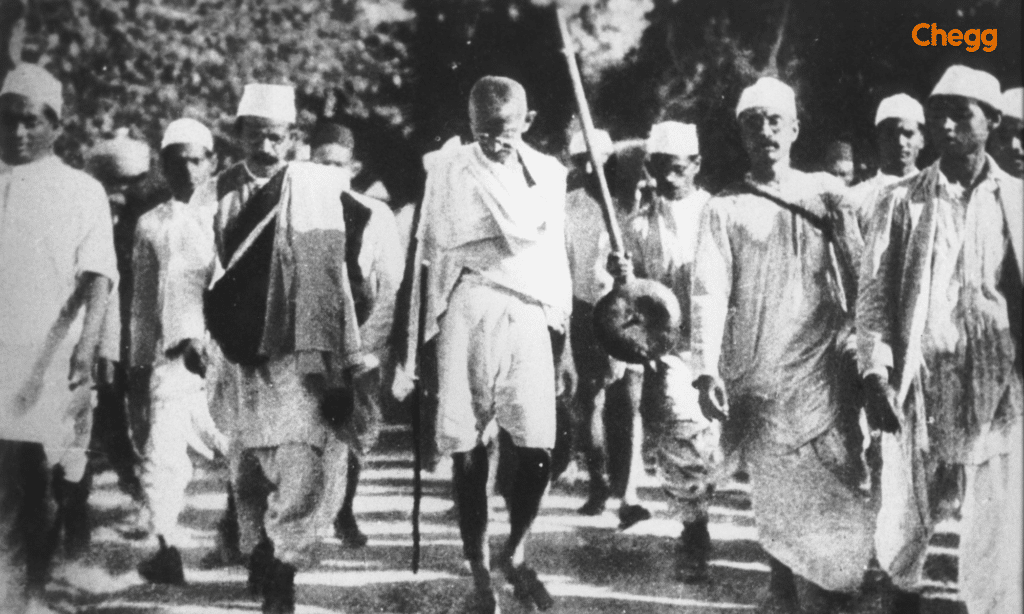
Quick Summary
Table of Contents
What Was the Rowlatt Act? The Rowlatt Act was enacted by the British government to tighten their control over the general population. It was passed in March 1919 by the Imperial Legislative Council, granting authorities the ability to detain individuals without trial. It allowed for the arrest and detention of individuals without trial, significantly curtailing civil liberties and enabling the authorities to suppress dissent. In response, Gandhi and other leaders organized a Hartal (work stoppage) to protest this law, known as the Rowlatt Satyagraha, to demonstrate Indian opposition to its enforcement.
The Rowlatt Committee, led by Sir Sidney Rowlatt, suggested it. Despite unanimous opposition from Indian council members, what was the Rowlatt Act the law was passed, leading to the resignation of Madan Mohan Malviya, Muhammad Ali Jinnah, and Mazhar ul Haq in protest. What Was the Rowlatt Act the implementation of What Was the Rowlatt Act caused massive protests and ultimately ignited the Indian War for independence. What was the Rowlatt Act? Here are the key points about the Rowlatt Act:
This highly controversial law sparked widespread outrage and resistance among the Indian population. In response, Gandhi and other leaders organized a Hartal (work stoppage) to protest this law, known as the Rowlatt Satyagraha, to demonstrate Indian opposition to its enforcement. What Was the Rowlatt Act the widespread discontent fueled by the Act ultimately led to significant unrest and culminated in the tragic Jallianwala Bagh where British troops opened fire on a peaceful gathering, resulting in hundreds of deaths.
This event further galvanized public sentiment against British rule and marked a pivotal moment in the Indian independence movement. What Was The Rowlatt Act, officially known as the Anarchical and Revolutionary Crimes Act of 1919, was a law enacted by the British government in India in response to growing unrest and revolutionary activities against colonial rule. The Act was named after Sir Sidney Rowlatt, who chaired the committee that recommended its provisions.
In 1919, the British colonial government enacted the Rowlatt Act in reaction to mounting discontent and nationalist movements in India. What Was the Rowlatt Act Designed to quell revolutionary activities and stifle the freedom struggle, officially known as the Anarchical and Revolutionary Crimes Act of 1919, was a repressive law enacted by the British government in India. What Was the Rowlatt Act its primary purpose was to curb the growing nationalist movements and dissent against British rule following World War I. What was the Rowlatt Act this legislation conferred broad powers upon colonial authorities to arrest and detain individuals indefinitely without trial.
The Rowlatt Act, officially known as the Anarchical and Revolutionary Crimes Act of 1919, had a specific objective when it was enacted. Here are the key points regarding its purpose:
The Rowlatt Act, formally known as the Anarchical and Revolutionary Crimes Act of 1919, What Was the Rowlatt Act a legislative measure enacted by the British colonial government in India. Its primary purpose was to address the increasing unrest and revolutionary activities that posed a challenge to British authority in the region.
The Act aimed to suppress political dissent and prevent the rise of nationalist movements advocating for Indian independence.
What Was the Rowlatt Act, The Rowlatt Act sparked widespread outrage among the Indian populace, who viewed it as a violation of fundamental rights. Prominent leaders, including Mahatma Gandhi, mobilized protests against the Act, leading to the Rowlatt Satyagraha campaign.
The discontent surrounding what was the Rowlatt Act contributed to significant unrest, culminating in the Jallianwala Bagh massacre on April 13, 1919, where British troops opened fire on a peaceful gathering, resulting in numerous casualties. What Was the Rowlatt Act this tragic event intensified anti-British sentiments and marked a crucial turning point in the Indian independence movement.
Public Reaction and Protests
Consequences and Repeal
Certainly! Here’s a table outlining the timeline of the Rowlatt Act:
| Event | Date | Details |
|---|---|---|
| Introduction of the Act | February 1919 | The Rowlatt Act was introduced, based on the recommendations of the Rowlatt Committee. |
| Passage of the Act | 18 March 1919 | The Imperial Legislative Council passed the Rowlatt Act. |
| Act Came into Effect | 21 March 1919 | The act came into effect, extending emergency measures like indefinite detention without trial. |
| Arrest of Congress Leaders | 10 April 1919 | Dr. Satyapal and Saifuddin Kitchlew were arrested, leading to strong protests in Punjab. |
| Jallianwala Bagh Massacre | 13 April 1919 | British troops fired on a large crowd in Amritsar, causing hundreds of deaths and injuries. |
| Rowlatt Satyagraha | 6 April 1919 | Mahatma Gandhi called for a nationwide protest against the Rowlatt Act. |
| Repeal of the Act | 1922 | The Rowlatt Act was repealed by The Special Laws Repeal Act. |
In this What Was the Rowlatt Act, the British government, alarmed by the specter of terrorism and revolutionary movements, viewed the Rowlatt Act as a tool to suppress these perceived threats. What Was the Rowlatt Act it faced widespread criticism from Indians due to its harsh measures. Indians felt that the Act violated fundamental rights and liberties, fueling widespread discontent and protests across the country. What Was the Rowlatt Act However, this legislation faced widespread criticism from Indians due to its harsh measures:
During India’s struggle for independence, which marked the Gandhian era in its political history, What was the Rowlatt Act had significant impacts:
Among various Indian leaders, Mahatma Gandhi openly condemned the Act, What Was the Rowlatt Act arguing against penalizing innocent country folk for individual political offenses. In protest, Madan Mohan Malaviya and Muhammad Ali Jinnah, representing the All-India Muslim League, resigned from the Imperial Legislative Council. What Was the Rowlatt Act, this action sparked outrage among other Indian politicians and the general public, leading the government to resort to oppressive measures. Gandhi and his followers believed that constitutional opposition to what was the Rowlatt Act would be ineffective, prompting them to stage a hartal on April 6, 1915.
What Was the Rowlatt Act: The Rowlatt Satyagraha, led by Mahatma Gandhi, emerged as a significant response to the oppressive Rowlatt Act, marking a pivotal moment in India’s quest for independence. It represented the first large-scale, organized application of non-violent civil disobedience against British rule.
What Was the Rowlatt Act, Under Gandhi’s leadership, the movement advocated disciplined protests such as hartals (strikes), economic boycotts, and non-cooperation. It garnered enthusiastic support from the Indian populace and witnessed widespread participation across all segments of society. What Was the Rowlatt Act, The Rowlatt Satyagraha underscored the unity of purpose among Indians in their struggle against colonial oppression.
The Jallianwala Bagh Massacre, which occurred on April 13, 1919, in Amritsar, Punjab, is one of the most tragic events in Indian history. On that day, thousands of Indians gathered peacefully in Jallianwala Bagh to protest against the oppressive Rowlatt Act and to celebrate the festival of Baisakhi.
What Was the Rowlatt Act, Brigadier General Reginald Dyer, perceiving the gathering as a threat, ordered his troops to open fire on the crowd without warning. The soldiers fired for about ten minutes, resulting in the deaths of approximately 379 people and injuring over 1,200 others, though the actual numbers are believed to be higher. Many victims were trampled in the chaos as they attempted to escape.
The Jallianwala Bagh Massacre stands as one of the most harrowing events in the history of British colonial rule in India. What Was the Rowlatt Act this tragic incident not only highlighted the brutal nature of colonial governance but also served as a catalyst for the Indian independence movement.


The Class 10 curriculum focuses on the rise of Indian nationalism. What Was the Rowlatt Act is a prime example of how British policies fueled these sentiments. It shows the growing tension between British rule and the Indian people’s desire for self-governance.
Here are some multiple-choice questions (MCQs) related to the Rowlatt Act of 1919:
The Rowlatt Act of 1919 isn’t just another historical tidbit in your Class 12 curriculum. It was a turning point that shaped the Indian independence movement. Here’s why it matters:
The Rowlatt Act is more than a fact; it unlocks a deeper understanding of the fight for freedom and its lasting impact on India.
Most of the time, this question is asked in class 12:
Ans: The British government in colonial India passed a piece of legislation in 1919 known as the Anarchical and Revolutionary Crimes Act, but more popularly called the Rowlatt Act. Here are the key points about the Rowlatt Act:
This What Was the Rowlatt Act, the Act passed by the British colonial administration in 1919, provoked resentment among Indians because of its repressive measures that limited civil freedoms. The enactment of the act and its ramifications heightened India’s quest for independence, sparking rallies, marches, and a united movement against British rule. The event’s significance stems from its position as a spark for the nationalist movement, revealing the harsh nature of colonial rule and inspiring Indians to aspire for independence.
Also Read:-
Hindu Marriage Act 1955: Origin, Insights & Provisions.
Right to Education Act 2009: RTE Main Fеaturеs & Provisions
104 Amendment of Indian Constitution – Impact & Rationale, Act.
Along with the What Was the Rowlatt Act, Read the related articles by visiting the above links.
The Rowlatt Act granted the government the authority to arrest individuals suspected of revolutionary activities against the British regime without a trial. The Act’s main goal was to stop the nation’s rising nationalist movement. Mahatma Gandhi urged the populace to oppose the act with satyagraha.
The Rowlatt Act was often referred to as the “black act.”
The Rowlatt Act’s primary goal was to restrict Indian citizens’ fundamental rights. The Rowlatt Act was created with the intention of fully stifling political activity in India by endowing the government with vast powers.
Referred to as the “Black Act” by Gandhi, the Rowlatt Act was passed by the British. The act greatly overreached the police in terms of power. Nobody needed a warrant to be arrested, and anyone may be held without one.
There were protests against the Rowlatt Act of 1919 in a number of cities. Railway workshops saw a walkout by workers. Ships ceased operations. The tragic Jallianwala Bagh Massacre occurred in protest of the Rowlatt Act.
The announcement that well-known Indian leaders had been detained and expelled from Amritsar provoked violent riots on April 10; during these demonstrations, soldiers opened fire on citizens, houses were plundered and set on fire, and enraged crowds brutally attacked a Christian missionary and killed many foreigners.

Authored by, Amay Mathur | Senior Editor




Amay Mathur is a business news reporter at Chegg.com. He previously worked for PCMag, Business Insider, The Messenger, and ZDNET as a reporter and copyeditor. His areas of coverage encompass tech, business, strategy, finance, and even space. He is a Columbia University graduate.
Editor's Recommendations
Chegg India does not ask for money to offer any opportunity with the company. We request you to be vigilant before sharing your personal and financial information with any third party. Beware of fraudulent activities claiming affiliation with our company and promising monetary rewards or benefits. Chegg India shall not be responsible for any losses resulting from such activities.
Chegg India does not ask for money to offer any opportunity with the company. We request you to be vigilant before sharing your personal and financial information with any third party. Beware of fraudulent activities claiming affiliation with our company and promising monetary rewards or benefits. Chegg India shall not be responsible for any losses resulting from such activities.